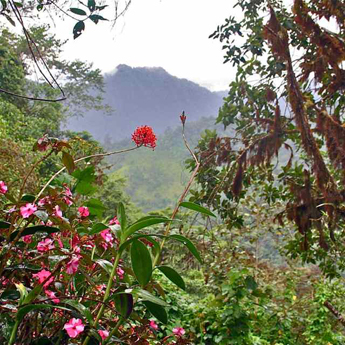Day1
Arrival to Quito, short transfer to the hotel. Depending on the arrival time we might spot the Vermillion Flycatcher, Rufous-collared Sparrow, Black-tailed Trainbearer and Sparkling Violet-Ear.
Day2
Early morning start and travel to the NW Highlands, birding en-route at Yanacocha area and on the Nono Road. Each stop we make on our way will surprise us with Empress Brilliant, Collared and Brown Inca, Green-fronted Lancebill and Booted Racket-tail, Hoary, Golden-breasted and Black-breasted Puffleg. There is a chance to find some of the Antpitta species like Undulated and Rufous Antpitta. Other potential interesting species include Andean Guan, Bar-bellied Woodpecker, Barred Fruiteater, Rainbow-bearded, Thornbill and Black-chested Mountain-Tanager.
Roadside rivers can hold Torrent Duck, other waters Fasciated Tiger-Heron, while the skies will be ruled by Plain-breasted Hawk, Black-chested Buzzard Eagle, Black-and-chestnut Eagle and Ornate Hawk-Eagle.
Finally we end up at our charismatic lodge, Bellavista where we will be based for 3 nights. Each evening we can look in the premises of the lodge for Common Potoo, Lyre-tailed or Swallow-tailed Nightjar and Rufous-bellied Nighthawk.
Day3
We spend a full day around Bellavista in search of Toucan Barbet, Masked Trogon, Plate-billed Mountain Toucan and flocks of Tanagers such as Metallic Green, Flame-faced, Silver-throated, Grass Green, Orange-eared, Golden-naped, Fawn-breasted, Blue-capped and Blue-winged Mountain Tanager.
Hummingbird feeders attract Brown and Collared Inca, Tawny-bellied Hermit, Green and Sparkling Violetears, Western and Andean Emeralds, Fawn-breasted Brilliant, Speckled Hummingbird, Buff-tailed Coronet, Gorgeted Sunangel, Purple-bibbed Whitetip, Booted Racket-tail and Purple-throated and White-bellied Woodstars. Some of the sought-after and often seen species around the lodge include Beautiful Jay, White-faced Nunbird, Chestnut-crowned and even Giant Antpitta, Ocellated Tapaculo, Golden-headed and Crested Quetzal, Plushcap, the localised Tanager Finch and the incredible Andean Cock-of-the-Rock.
Spillman's and Narino Tapaculos, Green-and-black Fruiteater, Tri-coloured Brush-Finch, Southern Yellow Grosbeak, Long-tailed Antbird, Olivaceous Piha, Turquoise Jay, Masked and White-sided Flowerpiercers, Andean Solitaire, Black-crested and Three-striped Warblers, White-tailed and Rufous-winged Tyrannulets are encountered quite regularly as well.
Day4
After a very early start today we travel to the World famous Mindo Valley. Among many others here we will visit "la Paz de las Aves" which is a great place to take photos of Giant Antpittas. The cloudforests of the Mindo Valley Reserve are home to a huge variety of birds including Velvet-Purple Coronet, Rufous-breasted Ant-thrush, Long-wattled Umbrellabird, Club-winged Manakin, Scaled Fruiteater, Yellow-collared Chlorophonia, Toucan Barbet, Choco Toucan, Golden-headed Quetzal, Crimson-rumped Toucanet, Pale-mandibled Aracari and Flame-faced, Golden-naped, Golden, Black-capped and Beryll-spangled Tanagers .
Later on we visit one of the finest sites in all of Ecuador at Milpe. This is a great place for plenty of the Chocó endemics such as Choco Toucan, Choco Screech-Owl, Choco Trogon and many more.
Los Bancos is another site where many sought-after and highly localised endemics occur, including Guayaquil Woodpecker, Pacific Hornero, Moss-backed Tanager and Pale-mandibled Aracari.
Day5
Birding in the morning around Bellavista and later on the way around Alambi will be a great way to say goodbye to this amazing birding paradise. During the afternoon we have a long drive plus short birding stops and finally we arrive to San Isidro in the Eastern Cordilleras.
Days6-7
We will visit some of the lower slopes of Antisana volcano for Andean Condor, Carrunculated Caracara, Andean Lapwing, Aplomado Falcon, Andean Gull, Ecuadorian Hillstar and Black-billed Shrike-Tyrant.
We will drive through Papallacta Pass, stopping at suitable birding sites trying to find Noble Snipe, Rufous-bellied Seedsnipe and Tawny Antpitta. Before leaving this spectacular area we also spend some time at Guango and San Isidro. We hope to see Scarlet-bellied, Lacrimose, Buff-breasted and Hooded Mountain-Tanagers, Grey-hooded Bush-Tanager, while hummingbirds will be represented by Mountain Velvetbreast, Sword-billed Hummingbird, Tourmaline Sunangel, Mountain Avocetbill, Golden-breasted and Glowing Pufflegs, White-bellied and Gorgeted Woodstars.
Close to our accommodation there are good places to search for several additional species such as Capped Conebill, Lacrimose Mountain-Tanager, Plain-tailed Wren, Chestnut-bellied Thrush, Rufous-breasted Flycatcher, White-bellied Antpitta, White-capped Tanager, White-rimmed Brush-Finch, Blackish, Ash-coloured and Equatorial Rufous-vented Tapaculos, Rufous-breasted Chat-Tyrant, Smoky Bush-Tyrant, Rufous-crowned Tody-Tyrant and many more.
Finally we return back to Quito for one night.
Day8
We return to Quito airport for your flight back home. Depending on the flight schedule there is a possibility of a last morning birding or a visit in the colonial centre of the city.
Day9
Overnight flight, arrival home.






























